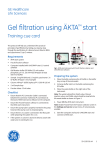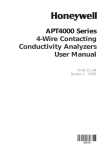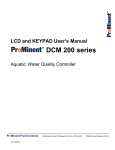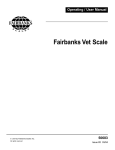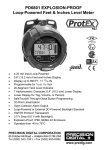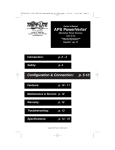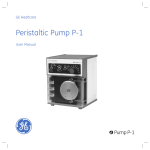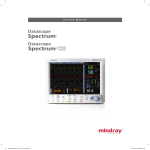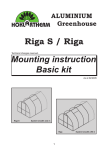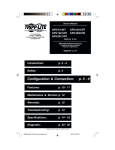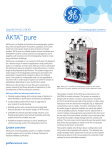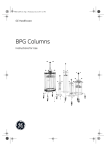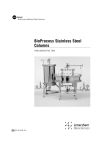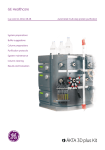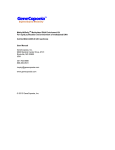Download GradiFrac User Manual - GE Healthcare Life Sciences
Transcript
A M E R S H A M B I O S GradiFrac C ™ User Manual 56-1006-08 Edition AF I E N C E S Important user information Reading this entire manual is recommended for full understanding of the use of this product. w The exclamation mark within an equilateral triangle is intended to alert the user to the presence of important operating and maintenance instructions in the literature accompanying the instrument. Warranty and Liability Amersham Biosciences AB guarantees that the product delivered has been thoroughly tested to ensure that it meets its published specifications. The warranty included in the conditions of delivery is valid only if the product has been installed and used according to the instructions supplied by Amersham Biosciences AB. Amersham Biosciences AB shall in no event be liable for incidental or consequential damages, including without limitation, lost profits, loss of income, loss of business opportunities, loss of use and other related exposures, however caused, arising from the faulty and incorrect use of the product. Trade marks Should you have any comments on this manual, we will be pleased to receive them at: GradiFrac™, HiLoad®, HiTrap®, RESOURCE® and Superloop™ are the exclusive trade marks of Amersham Biosciences AB. In view of the risk of trade mark degeneration, it is respectfully suggested that authors wishing to use these designations refer to their trade mark status at least once in each article. Amersham Biosciences AB S-751 82 Uppsala Sweden Copyright© 1997 Amersham Biosciences AB Amersham Biosciences AB reserves the right to make changes in the specifications without prior notice. All rights reserved. No part of this publication may be reproduced, stored in a retrieval system or transmitted in any form or by any means, without permission in written form from the company. Contents 1. 2. 3. 4. 5. Introduction .....................................................................................3 Description .......................................................................................4 2.1 Front Panel..............................................................................4 2.2 Rear panel ...............................................................................5 2.3 Power supply...........................................................................6 2.4 Tube racks ...............................................................................6 2.5 Delivery arm and tube sensor ..................................................7 2.6 Solenoid valves ........................................................................7 2.7 Delivery tubing........................................................................8 Accessory equipment ........................................................................9 3.1 System components .................................................................9 3.2 Rack........................................................................................9 3.3 Pumps .....................................................................................9 3.4 Mixer ....................................................................................10 3.5 Solenoid valves ......................................................................10 3.6 Injection valve .......................................................................10 3.7 Recorder................................................................................10 3.8 Monitor.................................................................................11 Unpacking and assembly ................................................................12 4.1 Unpacking .............................................................................12 4.2 Assembling tube racks ...........................................................12 4.3 Mounting the bowl................................................................15 4.4 Inserting tubes .......................................................................16 4.5 Adjusting the delivery arm.....................................................16 4.6 Fitting the delivery tubing......................................................16 4.7 Mounting solenoid valves......................................................16 4.8 System mounting ...................................................................17 4.9 System connection .................................................................18 4.10 Tubing connections................................................................20 4.11 Starting the system ................................................................21 4.12 Turning the system off ...........................................................21 Setup and programming..................................................................22 5.1 GradiFrac Main menu ...........................................................22 5.2 Setup menu............................................................................22 5.3 Calibrating the pump ............................................................25 5.4 Program Method menu .........................................................26 5.5 Programming a new method..................................................26 5.6 Editing an existing method ....................................................29 5.7 Documenting methods...........................................................30 5.8 Method examples ..................................................................30 6. Operation .......................................................................................33 6.1 Manual operation..................................................................33 6.2 Method-controlled operation ................................................35 7. Maintenance ...................................................................................37 8. Troubleshooting..............................................................................38 9. Technical specifications...................................................................40 10. Accessories......................................................................................41 11. Ordering information .....................................................................42 Appendix: System configuration............................................................44 Index.....................................................................................................46 1. Introduction 1. Introduction GradiFracTM (Code No. 18-1993-01) from Amersham Biosciences AB combines the functions of gradient programmer and programmable fraction collector for standard chromatography applications. It forms the basic unit of GradiFrac System, which includes GradiFrac, Pump P-1, Monitor UV-1, Recorder REC 102, Valve IV-7, Switch Valve PSV-50 and a mounting rack. Gradients are generated using a single pump and a switch valve. Easy-to-use programming allows automatic gradient formation for preprogrammed separation methods. Up to ten methods can be stored in the instrument memory. Stored methods are retained in memory even when the power is switched off. GradiFrac can also be used in manual control mode, and manual adjustments can be made while a method is running. GradiFrac can be programmed to collect fractions based on time, volume or drop count. Fractions can also be collected in a peak detection mode when a suitable monitor is connected. Tube racks accommodate tubes with diameter 10-18 mm and length 50-180 mm. 3 2. Description 2. Description 2.1 Front Panel The front panel consists of an alphanumerical LCD display window and a keyboard with membrane keys. Fig. 1. GradiFrac front panel. The keyboard is divided into numerical keys and function keys. 2.1.1 Numerical keys are used for entering values during programming and manual control. 2.1.2 Function keys are used during both programming and operation. The main functions are briefly summarized below, and are described in more detail as required in the appropriate sections. Step through the control and programming menus. You can use the arrow keys whenever the display shows an up, down or double arrow. ENTER end feed tube Y/N pause 4 Enters parameters as shown in the display during programming and manual control. Acknowledges error messages. Stops manual operation. Interrupts method operation before the method is completed. Finishes work in the various menu blocks and returns to the main menu. Advances the fraction collector one position (except when GradiFrac is paused) The tube feed is delayed according to the Setup value for Delay UV to Frac if the flow rate is not zero. Switches between display of Yes and No answers to prompts in manual control and method programming. Pressing ENTER accepts the displayed answer. Pauses all manual or method-controlled operation without ending the method. Pressing continue restarts operation. 2. Description hold con tinue 2.2 Rear panel Holds method time or volume and holds gradient at the current concentration. All other functions continue uninterrupted. Pressing continue restarts the gradient. Resumes normal operation from the paused or held state. The power supply switch and electrical connections for accessories are mounted on the rear panel. Fig. 2. GradiFrac rear panel. The rear panel switches and connectors are described briefly below. See Section 4.9 for more details of connecting accessories to GradiFrac. ON/OFF Tube sensor Power Mixer Frac Aux Switch Pump When the red circle is visible the instrument is off. Connector for tube sensor and drop counter (mounted on the delivery arm). Connector for 24 V DC power supply. A power conversion unit for use with 100-240 VAC mains is supplied with GradiFrac. Connector for supplying power to Amersham Biosciences Mixer 0.6 ml. Connector for flow diversion valve (PSV-50), which diverts flow between fraction tubes and waste. Connector for auxiliary valve (PSV-50). Connector for gradient switch valve (PSV-50). 15-pin D-SUB connector for control of pump (e.g. Pump P1 or HiLoad Pump P-50). Recorder Start/Stop Signal for starting and stopping the recorder chart. Event mark Event marker signal, activated at fraction collector start and at each tube change. GND Ground for start/stop and event marker signals. Grad 1V Signal for recording the gradient (0-1 V corresponding to 0–100% B). A GND Analogue ground for the gradient signal. 5 2. Description Monitor Input DIP switches to set the monitor signal range. The switches should be set to correspond to the full-scale output from the monitor (Figure 3). Input connector from the monitor. The monitor signal is used for peak detection. ➔ ➔ ➔ ➔ ➔ ➔ Range Fig. 3. DIP switch settings for monitor output voltages. 2.3 Power supply GradiFrac uses a 24 V DC power supply, eliminating the need for fuses or circuit breakers in the instrument. A power conversion unit for use with 100-240 VAC mains is supplied with GradiFrac. The power conversion unit must be placed in a dry place. Note: GradiFrac should only be connected to a power supply recommended by Amersham Biosciences. 2.4 Tube racks Fraction tubes are held in racks which fit into the bowl of GradiFrac. Three standard racks are available: 1. 12 mm rack for 175 tubes, diameter 12 mm. 2. 18 mm rack for 95 tubes, diameter 10-18 mm. 3. 30 mm rack for 40 tubes, diameter 30 mm. GradiFrac is delivered with the 18 mm rack. The other racks are available as optional accessories. The 12 mm and 18 mm racks can be assembled to accommodate tube lengths 50-85 mm or 85-180 mm. The 30 mm rack can be assembled to accommodate tube lengths 30-50 mm, 50-85 mm or 85-180 mm. For correct operation, all tubes in a collection sequence must be of the same size. See Section 4.2 for details of tube rack assembly. Note: In the 18 mm rack, tubes longer than 100 mm should have diameters at least one tenth of the length. Otherwise pressure from the delivery arm can force the tube toward the centre of the rack. Tubes are arranged in the rack in a counter-clockwise spiral from the outside edge in to the centre. Tube positions are numbered on the tube holders. Custom tube racks can be made from block styrofoam or by drilling tube holders from plastic plates of the appropriate size. It is important that the angle and distance between tubes are not too great so that tube changes can be made smoothly. During operation, the bowl and tube rack are turned by the rubber-covered drive sleeve at the side of the GradiFrac base. The position at which the rack stops for each tube is determined by the tube sensor on the delivery arm (see below), so that the rack will not stop in an empty tube position. A safety feature stops collection automatically if rotation of the bowl is obstructed. 6 2. Description 2.5 Delivery arm and tube sensor The delivery arm carries the delivery tubing, tube sensor and drop counter. The cable (carrying both tube sensor and drop counter signals) is connected to the Tube sensor contact on the rear panel or GradiFrac. Fig. 4. Delivery arm and tube sensor. The delivery arm has three stationary positions. At rest it is located over the waste collector in the centre of the bowl. It can also be drawn gently outwards to two positions beyond the radius of the bowl for unhindered access to the tube rack. During operation, the delivery arm is tensioned inwards and rests with the tube sensor against the edge of a tube (where present). The height of the arm can be adjusted with the lock knob on the support rod. The tube sensor detects the presence of tubes in the tube rack. If a tube is missing, the delivery arm will swing inwards until a tube is detected or the centre position is reached. Note that the spiral tube sequence will be interrupted in such circumstances. The red sensor control switch at the end of the delivery arm adjusts the tube sensor for large or small diameter tubes. Turn the switch to the smaller marking for tubes in the 12 mm rack, and to the larger marking for tubes in the 18 and 30 mm racks. The delivery tubing is inserted into the tubing holder. A tubing length guide is provided midway along the upper side of the delivery arm to help in positioning the end of the delivery tubing correctly with respect to the drop counter. This guide is a small hole with a white ring. See Section 4.6 for a description of how to fit the delivery tubing correctly. 2.6 Solenoid valves The supplied solenoid valves PSV-50 may be connected to the ports marked Frac and Switch on the rear panel of GradiFrac, with the following functions: Frac Diverts flow to waste when fractions are not being collected (fraction size is set to 0). Switch Switch valve for gradient formation. 7 2. Description The port marked Aux is for an optional third solenoid valve, e.g. for threebuffer systems and for automatic application of large sample volumes. Solenoid valve PSV-50 has three outlets: IN NO Normally open NC Normally closed See Figures 13 and 14 for tubing connections to the valves. 2.7 Delivery tubing 8 0.8 mm i.d. tubing is recommended and is supplied with GradiFrac. Tubing connector/M6 (Code No. 19-1993-50) is used for connection. 3. Accessory equipment 3. Accessory equipment 3.1 System components Recommended components for use together with GradiFrac are listed below. Some typical system arrangements are illustrated in the appendix. Component Recommended models Rack GradiFrac System Rack Pumps Peristaltic Pump P-1 HiLoadTM Pump P-50 Solenoid valves PSV-50 for gradient formation PSV-50 for flow diversion PSV-50 for sample application or three-buffer systems (optional) Manual valves IV-7 Mixer Mixer 0.6 ml Monitor UV-1 Recorder REC 102 Columns Prepacked HiLoadTM and HiTrapTM columns (see Chapter 10) 3.2 Rack A rack (Code No. 18-1993-05) is available for convenient mounting of system components. 3.3 Pumps Recommended pumps for use with GradiFrac are Pump P-1 for flow rates 0-8.3 ml/min and HiLoad™ Pump P-50 for flow rates up to 50 ml/min. Other pumps may also be used provided that the pump speed is frequencycontrolled. GradiFrac controls pump speed by a pulsed output signal with frequency range 0-4 kHz. The programmable flow rate range is 0–99.9 ml/min. The pump calibration constant can be entered directly if known, or the pump can be calibrated by collecting a measured volume. See Section 5.3 for details of pump calibration. Connection to GradiFrac: 15 pin D-SUB. Recommended cable: Communication cable (Part No. 19-6005-02). 9 3. Accessory equipment Pump connector pin assignments: Pin no Function (1-6) 7 (8) 9 10 (11) 12 13 14 15 (Not used in GradiFrac) 0 V (ground) (Not used in GradiFrac) Pump busy Pump operable (Not used in GradiFrac) Pump control Frequency from pump (for calibration) Frequency to pump (pump speed) 0 V (ground) As long as GradiFrac is switched on, the pump is controlled entirely from GradiFrac. To use the controls on the pump itself, switch off the power to GradiFrac or disconnect the pump communication cable. 3.4 Mixer Amersham Biosciences Mixer 0.6 ml is suitable for most applications using GradiFrac. For high flow rates (above 8 ml/min), Mixer 6.0 ml is recommended. Mixer 0.6 ml is connected to the Mixer port on the rear panel of GradiFrac, which supplies power to the mixer (24 V AC, 50 Hz). The mixer operates as long as GradiFrac is turned on. Mixer 6.0 ml cannot be supplied with power from GradiFrac and requires a separate power source. 3.5 Solenoid valves Solenoid valve PSV-50 should be used with GradiFrac. PSV-50 may be connected to the ports marked Frac, Switch and Aux on the rear panel of GradiFrac, with the following functions: Frac Diverts flow to waste when fractions are not being collected (fraction size is set to 0). Switch Switch valve for gradient formation. Aux Optional third switch valve, e.g. for three-buffer systems and for automatic application of large sample volumes. 3.6 Injection valve Injection Valve (IV-7) is recommended for sample application. If desired, a system may be configured with the auxiliary switch valve as a sample application valve (see Appendix). 3.7 Recorder Recorders such as Amersham Biosciences REC 101 and REC 102 as well as other recorders are suitable for use with GradiFrac. The recorder is connected to the port(s) marked Recorder on the rear panel of GradiFrac. Use the Recorder Cable packed in the GradiFrac box (Code No. 56-1136-67). (The ordering number for the Recorder Cable is 18-1107-88.) The port connections have the following functions: Start/Stop Start and stop the recorder chart. The chart drive will operate as long as the flow rate is not zero. 10 3. Accessory equipment Event marker signal, activated at fraction collector start and markat each tube change. The signal is a short (50 ms) pulse. GND Ground for start/stop and event marker signals. For two-channel recorders, GradiFrac supplies a signal corresponding to the buffer gradient: Grad 1V Signal for recording the gradient (0–1 V corresponding to 0–100% B). A GND Analogue ground for the gradient signal. Event 3.8 Monitor Monitor UV-1 is recommended for use with GradiFrac. The output from the monitor is connected to the Monitor +, – ports on the rear panel of GradiFrac to supply a signal for peak detection functions. Recommended cable: Signal cable (Part No. 19-6006-01). The Range switches on the rear panel of GradiFrac should be set to the fullscale output from the monitor (10 mV for Monitor UV-1). The output from the monitor should be connected separately to the recorder and to GradiFrac. There is no output from GradiFrac for the monitor signal. An adaptor cable for connecting UV-1 to both GradiFrac and a recorder is supplied with GradiFrac. 11 4. Unpacking and assembly 4. Unpacking and assembly 4.1 Unpacking Unpack the GradiFrac carefully and check the contents of the carton against the included packing list. Inspect each item for damage that may have occurred during transit. Save the packing material and carton for later use. 4.2 Assembling tube racks Tube racks are assembled in the GradiFrac bowl from some or all of tube holder, tube guide and tube support (Figure 5). Details of assembly differ according to the length and diameter of the tubes. tube support rib L-shaped cutout tube guide single cutout tube holder Fig. 5. Tube rack components. Components of the tube rack are positioned in the bowl by engaging the cutouts (either single or L-shaped) on the edge of the component with the ribs on the inside of the bowl. This ensures that the different components are correctly aligned with each other. 12 4. Unpacking and assembly 4.2.1 Tube racks 12 mm and 18 mm. Tube lengths 50-85 mm L-shaped cutout single cutout same tube number Fig. 6. Assembly of 12 mm and 18 mm tube racks for 50-85 mm tubes. 13 4. Unpacking and assembly Fit the tube support, using the L-shaped cutouts. The support should be seated in the lower position in the bowl with the circular marks on the underside. Fit the tube guide in the bowl with the tube numbers facing up, using the single cutouts. The guide should come to rest approximately 1 cm above the tube support. Fit the tube holder in the bowl with the tube numbers facing up, using the single cutouts, ensuring that tube position 1 is directly above tube position 1 in the tube guide. The tube holder is held in position by the indentations in the ribs of the bowl. Check that the tube holder is level and firmly seated before filling it with tubes. Tube lengths 85-180 mm L-shaped cutout same tube number Fig. 7. Assembly of 12 mm and 18 mm tube racks for 85-180 mm tubes. Do not use the tube support. Fit the tube guide in the bowl with the tube numbers facing up, using the L-shaped cutouts. The guide should be seated in the lower position in the bowl. Fit the tube holder in the bowl with the tube numbers facing up, using the single cutouts, ensuring that tube position 1 is directly above tube position 1 in the tube guide. The tube holder is held in position by the indentations in the ribs of the bowl. Check that the tube holder is level and firmly seated before filling it with tubes. 14 4. Unpacking and assembly 4.2.2 Tube rack 30 mm. Tube lengths 30-50 mm Tube holder, 30 mm Tube guide, 30 mm Tube guide, 18 mm single cutouts Fig. 8. Assembly of 30 mm tube racks for 30-50 mm tubes. Fit the tube guide from the 12 or 18 mm rack, using the single cutouts. Fit the tube support on top of the tube guide to give the extra height necessary when using short tubes. Fit the 30 mm tube guide, using the single cutouts. Fit the tube holder in the top of the bowl with tube position 1 directly above tube position 1 in the tube guide. Tube lengths 50-85 mm Fit the tube support using the L-shaped cutouts. The support should be seated in the lower position. Fit the tube guide using the single cutouts. Fit the tube holder in the top of the bowl with tube position 1 directly above position 1 in the tube guide. Tube lengths 85-180 mm Do not use the tube support. Fit the tube guide in the bowl with the tube numbers facing up, using the L-shaped cutouts. The guide should be seated in the lower position in the bowl. Fit the tube holder in the bowl with the tube numbers facing up, ensuring that tube position 1 is directly above tube position 1 in the tube guide. The tube holder is held in position by the indentations in the ribs of the bowl. Check that the tube holder is level and firmly seated before filling it with tubes. 4.3 Mounting the bowl Move the delivery arm out to the second stop. Place the bowl containing the rack over the central spindle. Pull the spring-loaded drive sleeve away from the bowl so that the bowl drops into position. 15 4. Unpacking and assembly The bowl should come to rest with a gap of approximately 1 cm between the bottom of the bowl and the GradiFrac base. 4.4 Inserting tubes Insert sufficient collection tubes into the rack beginning at position 1. Ensure that the tubes are pushed down as far as possible. All tubes in one collection sequence must be of the same length and diameter and there should be no empty spaces. 4.5 Adjusting the delivery arm 1. Move the arm by lifting it a little so that the tube sensor comes to rest against a tube in the outer row. 2. Loosen the lock knob on the column. 3. Adjust the height of the arm so that the tube sensor is about 5 mm below the top of the tubes and tighten the lock knob. 4. Rotate the rack anti-clockwise by hand until the sensor comes to rest against the tube in position 1. Ensure that the red sensor switch is correctly set for the tube diameter (to the smaller marker for 12 mm racks and to the larger marker for 18 and 30 mm racks). 4.6 Fitting the delivery tubing 1. 2. 3. 4. Cut the end of the delivery tubing cleanly at 90°. Lift out the tubing holder from the delivery arm and loosen the nut. Fit the delivery tubing through the tubing holder. Place the tubing holder over the length guide hole. Push the tubing through the holder until it reaches the bottom of the length guide, then tighten the nut on the tubing holder. This ensures that drops are formed in the correct position with respect to the drop counter. 5. Fit the tubing holder into the delivery arm. 4.7 Mounting solenoid valves Screw the valve holder to the back of the delivery arm using the screws provided. Attach the flow diversion valve PSV-50 to the valve holder (Figure 9). Fig. 9. Mounting the flow diversion valve. 16 4. Unpacking and assembly 4.8 System mounting Sections 4.8-4.10 describe assembly of GradiFrac System. System components are listed in Section 3.1. A separate System Installation Guide is available. 1. Prepare GradiFrac as described in Sections 4.2-4.7. 2. Attach the solenoid valve for gradient formation to the valve bracket. If an auxiliary valve is used, attach this to the same valve bracket alongside the gradient valve (Figure 10). Fig.10. Fitting the gradient valve to the valve bracket. The auxiliary valve can be fitted to the same bracket. 3. Assemble the rack as described in the instructions provided. 4. Prepare the other components for use as described in the respective User Manuals. 5. Place the system components in the rack as shown in Figure 11. 17 4. Unpacking and assembly Mixer P-1 IV-7 UV-1 control unit PSV-50 gradient valve GradiFrac UV-1 optical unit REC 102 Fig. 11. Placing the system components in the rack. 4.9 System connection w 18 Connect components electrically to GradiFrac as described below (Figure 12). Use a screwdriver to fit the green connectors supplied with GradiFrac to the valve, recorder and monitor cables that are to be connected to GradiFrac rear panel. Valve cables have no polarity and may be connected either way round. Connect the monitor cable with the polarity shown on GradiFrac rear panel and recorder cables as shown in Figure 12. All sockets on the rear panel must have their respective green connectors fully inserted to avoid the risk of electrostatic discharge (ESD). 4. Unpacking and assembly Fig. 12. Electrical connections. 4.9.1 Tube sensor Connect the tube sensor cable from the delivery arm to the Tube sensor contact on the rear panel of GradiFrac. (This cable may already be connected on delivery). 4.9.2 Pump Connect the Remote contact on the pump to the Pump contact on the rear panel of GradiFrac. 4.9.3 Valves Connect the flow diversion valve to the Frac port on the rear panel of GradiFrac. Connect the gradient valve to the Switch port on the rear panel of GradiFrac. Connect the auxiliary valve, if used, to the Aux port on the rear panel of GradiFrac. 4.9.4 Mixer Connect Mixer 0.6 ml to the Mixer port on the rear panel of GradiFrac. 19 4. Unpacking and assembly 4.9.5 Recorder Connect the recorder to the three-pin port marked Recorder (Start/stop, event mark, GND) and the two-pin port marked Recorder (GRAD 1V, A GND) on the rear panel of GradiFrac, using the special Recorder Cable packed in the GradiFrac box (Code No. 56-1136-67). (The ordering number for the Recorder Cable is 18-1107-88.) Connect the 15-pin D-SUB connector to the port on the rear panel of the recorder, and the red and black pin connectors to channel 2 (red) on the top of the recorder. Set the red switch on the recorder (voltage selector for channel 2) to 1 V. Note: Chart speed must be set locally on the recorder. The int/ext button on REC 102 should be in position int. The Rec on/off button should be in position on. 4.9.6 Monitor Set the DIP switch on the rear panel of GradiFrac (see Section 2.2) to correspond to the full-scale output from the monitor (10 mV for Monitor UV-1). Use the Y-cable supplied with GradiFrac to connect the monitor output to both GradiFrac and recorder. Connect the monitor output to the Monitor port on GradiFrac, taking care to match the + and – poles. Connect the monitor output separately to channel 1 input on the recorder. Set the blue switch on the recorder (voltage selector for channel 1) to correspond to the full-scale output from the monitor (10 mV for Monitor UV-1). 4.9.7 Power supply Connect the 24 V DC outletfrom the power conversion unit to the Power socket on the rear panel of GradiFrac. Connect the power conversion unit to the mains supply. The conversion unit adjusts automatically to mains voltages in the range 100-240 V AC, 50-60 Hz. 4.10 Tubing connections Connect tubing as shown in Figures 13 and 14. Make sure that the tubing connections to the solenoid valves are made to the correct valve outlets as shown in Figure 14. Fig. 13. Connecting tubing to PSV-50. 20 4. Unpacking and assembly Fig. 14. System tubing connections. 4.11 Starting the system Turn on the power to GradiFrac first, then to the other components in the system. 4.12 Turning the system off Turn off the power to the pump and recorder first. If GradiFrac is turned off while power is still supplied to pump or recorder, these instruments will start to run according to the settings on the instruments themselves. This can be particularly important for the pump, since liquid or air may otherwise inadvertently be pumped through the system. 21 5. Setup and programming 5. Setup and programming 5.1 GradiFrac Main menu The GradiFrac main menu is divided into four blocks: Main menu RUN METHOD Main menu MANUAL RUN Main menu PROGRAM METHOD Main menu SETUP Fig. 15. GradiFrac main menu. When GradiFrac is first switched on, the Run method option is displayed. Press the arrow keys to move between menu options. 5.2 Setup menu The Setup menu block sets general operation parameters. Setup should be performed when GradiFrac is first installed and whenever parameters need to be changed. Current setup parameters apply during manual operation and method programming. During method-controlled operation, the method base (time/volume) and fractionation base (time/volume/drop) which were current at the time of programming apply. All other Setup parameters during method-controlled operation are those which were last entered. Note that the method base and fractionation base are defined by those used in the most recently accessed method (either in Method Run or in Program method), unless they are actively reset in Setup. Switch on GradiFrac. After a short interval, the display shows: Main Menu Run Method Press the key three times until the display shows Main Menu Setup 22 5. Setup and programming Press ENTER to enter the setup block. Main menu RUN METHOD end METHOD BASE [time/vol] Main menu MANUAL RUN FRACTIONATE BY [time/vol/drop] Main menu PROGRAM METHOD CALIBRTN VALUE [pls/0.1 ml] ENTER Main menu SETUP PUMP CALIBRATION PROCEDURE ENTER START COLLECTING ENTER DELAY UV TO FRAC [µl] PRESS [end] TO STOP COLLECTING end MIX VOLUME [µl] ENTER COLLECTED VOLUME [ml] DROP SYNC ACTIVE [Y/N] Fig. 16. The Setup menu block. 5.2.1 Setting the method base Set the method base with Method base (Figure 16). Choose time (min) or volume (ml). The chosen base will apply for all subsequent programming of new methods. Previously stored methods however retain the method base in which they were programmed. METHOD BASE VOLUME (ml) [Y/N] N Y METHOD BASE TIME (min) [Y/N] N Y Fig. 17. Setting the method base. 5.2.2 Setting the fractionation base Set the fractionation base with Fractionate by (Figure 16). Choose time (min), volume (ml) or drops. The chosen base will apply for manual operation and for all subsequent programming of new methods. Previously stored methods however retain the fractionation base in which they were programmed. 23 5. Setup and programming FRACTIONATE BY VOLUME (ml) [Y/N] N Y FRACTIONATE BY TIME (min) [Y/N] N Y FRACTIONATE BY DROPS (drp) [Y/N] N Y Fig. 18. Setting the fractionation base. 5.2.3 Setting the pump calibration factor Set the pump calibration factor with Calibrtn value (Figure 16). The pump calibration factor is the number of pulses required to deliver 0.1 ml from the pump. Enter the value directly if known and press ENTER. If the calibration factor is unknown, see Section 5.3. Note that the calibration factor for Pump P-1 depends on the tubing diameter. You are advised always to perform pump calibration whenever the tubing is changed. The pump calibration factor will apply for all subsequent manual and method-controlled operation until a new value is set. 5.2.4 Setting the monitor-to-collector delay Set the delay volume between the UV monitor and the fraction collector with Delay UV to Frac (Figure 16). Enter the volume of liquid (in µl) in the delivery tubing between the UV monitor flow cell and the very end of the tubing. This will ensure that event marks on the UV absorbance trace on the recorder are synchronized with tube changes. Calculate the delay volume from the length of tubing. The volume of 0.8 mm i.d. tubing is 50 µl/10 cm. The delay volume will apply for all subsequent manual and methodcontrolled operation until a new value is set. 5.2.5 Setting the mixing volume Set the mixing volume with Mix volume (Figure 16). The mix volume is the total volume (µl) of liquid (buffer A + buffer B) which passes through the gradient valve during one cycle of operation. The value for the mix volume together with the flow rate thus determines the switching frequency of the valve. If the mix volume is too low, the switching frequency may be too high (the minimum cycle time for valve PSV-50 is 30 ms). If the mix volume is too high, the gradient will be inaccurate at low flow rates. The mix volume for Pump P-1 is calculated according to the table below: 24 5. Setup and programming Pump tubing i.d. (mm) Flow rate range (ml/min) Mixer (ml) Mix volume (µl) 1.0 0–1 0.6 Mix volume = 54 000 pump calibration factor 2.1 1–4 0.6 Mix volume = 18 000 pump calibration factor 3.1 3–5 0.6 Mix volume = 8 800 pump calibration factor 3.1 5–8 6.0 Mix volume = 18 000 pump calibration factor The following values are recommended for HiLoad Pump P-50: Flow rate (ml/min) Mixer (ml) Mix volume (µl) 0-5 >5 0.6 6.0 60 600 Note that the mix volume is not the same as the volume of the mixer. The mix volume will apply for all subsequent manual and methodcontrolled operation until a new value is set. 5.2.6 Setting drop synchronization Set drop synchronization with Drop sync active (Figure 16). If drop synchronization is active, tube changes will only occur directly after a drop is registered by the drop counter, to minimize spillage between tubes. Drop synchronization operates in all fraction collection modes (time, volume and drop). Drop synchronization is only possible at flow rates below 3 ml/min. The drop synchronization setting will apply for all subsequent manual and method-controlled operation until a new value is set. 5.3 Calibrating the pump To calibrate the pump, move to Pump calibration procedure in the Setup menu (Figure 16) and press ENTER. Follow the steps below: 1. Set the speed on the pump to a value close to the flow rate which will be used subsequently. For Pump P-1, use the flow rate guide supplied with the pump. 2. Make sure there are no air bubbles in the pump or delivery tubing. 3. Enter the setup block in the GradiFrac main menu. 4. Press until the display shows Pump calibration procedure, then press ENTER to enter the calibration process. The display will show Start collecting. 5. Place a suitable measuring vessel under the outlet tubing and press ENTER. The pump will start to operate and the display will show Stop collecting. 6. Collect a volume large enough for accurate measurement, then press end to stop collecting. The pump will stop and the display will show Enter collected volume. 7. Measure the collected volume, enter the value (ml) and press ENTER. GradiFrac will calculate the calibration factor, and the display will show the calculated value. 25 5. Setup and programming 8. Press end to return to the main menu or to continue with the setup menu. The calibration factor for HiLoad Pump P-50 is 234 pulses/0.1 ml. Enter this factor directly in the Setup menu if Pump P-50 is used. Pump calibration should only be necessary for Pump P-1 and other pumps with unknown calibration factors. 5.4 Program Method menu GradiFrac can store up to 10 methods of 52 breakpoints each. Main menu RUN METHOD end SELECT METHOD [0-9] FREE n Method occupied! Main menu MANUAL RUN CLEAR METHOD [Y/N] ENTER Y = new method Main menu PROGRAM METHOD N = edit method Main menu SETUP CE + ENTER EDIT BREAKPOINT [time/volume] TIME/VOLUME CONC %B TIME/VOLUME FLOW ml/min REMOVE CURRENT BREAKPOINT [Y/N] continue TIME/VOLUME FRACTN end TIME/VOLUME VALVE ACTIVE [Y/N] N END METHOD [Y/N] TIME/VOLUME PEAK COLLECT [Y/N] Y TIME/VOLUME SLOPE %/ml Y ALARM AT time/volume SHOW CONC %B ON REC OUT [Y/N] Fig. 19. The Program method control block. Each holds settings for all method parameters. During programming, the default settings for a new breakpoint are taken from the previous existing breakpoint in the method. 5.5 Programming a new method 5.5.1 Selecting a method number Choose Program Method in the main menu (Figure 15) and press Enter. Enter the number of the method to program. GradiFrac shows the number of the lowest empty method in the window, and suggests the most recently used number as default. If the method number is occupied, GradiFrac responds with the message Method occupied! To choose a new method number, press end to return to the main menu. To clear the existing method, press ENTER to acknowledge the message, then answer Y to the Clear method prompt. Answering N here allows you to edit the method (see Section 5.6). 26 5. Setup and programming 5.5.2 Entering breakpoints A method consists of a series of breakpoints which define changes in one or more control parameters. Methods are programmed on a time or volume base, according to the current setting in Setup (see Section 5.2). The first breakpoint must be at time/volume 0.0. An alarm can be set anywhere in the method, e.g. to alert the operator for manual sample application or to signal the end of the method. Note: If FRACTN, VALVE ACTIVE or PEAK COLLECT breakpoints are to be programmed within a gradient, then these breakpoints should be added after the gradient programming is completed. This avoids the need to calculate the exact value for CONC %B within the gradient. By programming as described above, GradiFrac will perform the calculation automatically. Move through the program method menu with the arrow or ENTER keys, setting breakpoint parameters as required. If several breakpoints have been set, you can move up and down through the breakpoints, changing parameters as required. 5.5.3 Programming gradient shape Set the concentration of buffer B with CONC %B (Figure 19). Two breakpoints with different values for concentration of B will create a linear gradient from the first to the second value over the interval between the breakpoints. For example, the following breakpoints give a gradient from 25 to 45 %B, starting at 5 minutes and extending over 10 minutes: TIME CONC %B 5.0 min 25 TIME CONC %B 15.0 min 45 Two gradient breakpoints separated by 0.1 ml or min will create a step gradient with an immediate change in buffer B concentration. For example, the following breakpoints cause an abrupt change from 25 to 45 %B at time 5 min. TIME CONC %B 4.9 min 25 TIME CONC %B 5.0 min 45 5.5.4 Programming flow rate Set the flow rate with Flow ml/min (Figure 19). A method cannot be programmed with zero flow rate. Any changes in flow rate are made instantaneously at the breakpoint (time or volume) where the new value is requested. 27 5. Setup and programming 5.5.5 Programming fraction size Set the fraction size with Fraction [min/ml/drop] (Figure 19). The fraction base (time, volume or drops) is determined by the current setting in Setup (see Section 5.2). As long as the fraction size is set to 0, the flow diversion valve will divert effluent to waste. 5.5.6 Programming the auxiliary valve Control the auxiliary valve where used with Valve active [Y/N] (Figure 19). The auxiliary valve is connected to the Aux port. Enter Y to activate the valve and N to deactivate the valve. The current setting is indicated by Y or N in the instruction prompt. 5.5.7 Programming peak collection Set peak collection with Peak collect [Y/N] (Figure 19). Enter Y to activate peak collection. The fraction size must be set to >0 for peak collection to be activated. This may be done in the same breakpoint as that in which peak collection is activated. If peak collection is activated, enter the threshold slope for peak detection as Slope %/ml. Values may be set from 1 to 99 %/ml. The fraction collector will change tubes whenever the slope exceeds the set value. The peak end is determined automatically by GradiFrac. The set fraction size applies both within and between peaks. The following procedure is recommended for determining a suitable slope value: 1. Use a previous chromatogram from an identical run to determine the slope %/ml (see Figure 19). Peak collection is not recommended with an unknown sample. 2. Perform a blank run with the chosen setting to check that tube changes do not occur as a result of baseline disturbances. If unwanted tube changes occur, set a higher slope value and repeat the run. AU 0.5 0.4 Monitor FSD = 0.5 AU Slope at peak start = 0.05 AU/ml Slope at peak start = 10% FSD 0.3 Peak collect slope = 10%/ml 0.2 Peak start 0.1 0 0.05 AU 1 ml 0 5 Fig. 20. Determining the slope value for peak collection (%/ml). 28 10 Elution vol (ml) 5. Setup and programming 5.5.8 Ending the method The method will end at the last breakpoint. If you require a period of constant parameters at the end of the method, enter a final breakpoint with the same parameters as the penultimate breakpoint (see the examples in Section 5.8). When all breakpoints have been entered, press end to end method programming and answer Y to the End method prompt. 5.5.9 Programming an alarm Set an alarm with Alarm at (Figure 19). If you want an alarm to sound during or after the method, enter a non-zero value here. For example, entering Alarm at 1 min will sound an alarm 1 minute after the method is started. 5.6 Editing an existing method To edit an existing method, choose Program method from the main menu. Select the number of the method and press enter. GradiFrac responds with the message: Method occupied! Press ENTER to acknowledge the message, then answer N to the Clear method prompt. You may now edit the breakpoints in the existing method. Use the arrow keys at the Edit breakpoint prompt to scroll through the existing breakpoints, or enter the time or volume for an existing breakpoint to move directly to that breakpoint. 5.6.1 Inserting a breakpoint To insert a breakpoint, enter the breakpoint time or volume at Edit breakpoint (Figure 19) and press ENTER. Set the parameter values as required. A newly entered breakpoint “inherits” default parameter settings from the closest previous breakpoint in the method. 5.6.2 Changing breakpoint parameters To change the time or volume for a breakpoint, insert a new breakpoint at the required time or volume as described in Section 5.6.1, then delete the unwanted breakpoint as described in Section 5.6.3. You may need to edit parameter settings for the new breakpoint. To change other parameters for an existing breakpoint, move to the required breakpoint, press ENTER, then change the parameters as required. Remember that all parameters are set at every breakpoint. A new parameter value must be entered for all breakpoints where it is to apply. This is particularly important for flow rate and fraction size which are often set early in a method and apply throughout the method. If for example the flow rate is changed only at the first breakpoint, the previous flow rate will be restored at the second breakpoint. 5.6.3 Deleting a breakpoint To remove an existing breakpoint, move to the required breakpoint and set the time/volume to 0 (use the CE key to clear the existing value). GradiFrac will ask you to confirm that the breakpoint should be deleted. 29 5. Setup and programming 5.7 Documenting methods The programmed gradient shape for any stored method may be documented on the recorder when method programming is completed. Set the recorder chart speed to 10 or 20 mm/s and answer Y to the prompt SHOW CONC %B ON REC OUT at the end of the Program Method block (Figure 19). The complete method is recorded in 10 s. It is important that you make notes of the purpose and structure of methods stored in GradiFrac. Without these, it is easy to forget the purpose of a method which is identified by number alone, and it may be difficult to reconstruct the method if it is accidentally deleted. The form on page 32 suggests a standard for recording method notes and breakpoints. 5.8 Method examples Example 1 illustrates a simple GradiFrac method for a gradient elution with a linear gradient from 0 to 60 %B then an instantaneous change to 100 %B. Peak detection is set to on. The sample is applied manually after 1 minute, and fraction collection starts at the beginning of the gradient (allowing 25 ml flow-through to run to waste). 100 %B 80 60 40 20 0 0 10 20 30 Fraction collection 40 50 min Fig. 21. Buffer gradient in the example method. Table 5-1. Breakpoints for example method 1. Values actively entered for each breakpoint are shown in bold. Unchanged values are grey. Time Conc %B 0.0 0 5 0 N N - Start method 5.0 0 5 0.5 N Y 5 Start gradient, start fractions 29.9 60 5 0.5 N Y 5 End gradient 30.0 100 5 0.5 N Y 5 Start column wash 44.9 100 5 0.5 N Y 5 End column wash 45.0 0 5 0 N N - End fractions start re-equilibration 50 0 5 0 N N - End method Alarm at 1 min 30 Flow Fractn Valve Peak Slope Comment Alert for sample application 5. Setup and programming Note the final breakpoint at 50 minutes which ensures that the method continues for 5 minutes after the concentration of B is reduced to 0. Example 2 shows illustrates a method with the same gradient as above, but using an auxiliary valve for sample application (see system configuration in Appendix). In example 2, fractions are collected between 10 and 20 minutes, starting and stopping within the gradient. Note how these breakpoints are entered after the gradient is programmed, allowing GradiFrac to calculate the value for CONC %B. Table 5-2. Breakpoints for example method 2. Values actively entered for each breakpoint are shown in bold. Unchanged values are grey. Time Conc %B Flow Fractn Valve Peak Slope Comment 0.0 0 5 0 N N - Start method 1.0 0 5 0 Y N - Start sample application 2.0 0 5 0 N N - End sample application 5.0 0 5 0 N N - Start gradient 29.9 60 5 0 N N - End gradient 30.0 100 5 0 N N - Start column wash 44.9 100 5 0 N N - End column wash 45.0 0 5 0 N N - Start re-equilibration 50.0 0 5 0 N N - End method 10.0 12 5 0.5 N Y 5 Start fractions 20.0 36 5 0 N N - End fractions Alarm at 50 min Signal method end 31 5. Setup and programming Method no:..................................................................... Author:............................. Column type: ............................................................... Auxiliary valve used? Setup parameters: Method base: time ❑ volume ❑ Pump calib. value: ...................... Mix vol:......................................... Fractionate by: time ❑ volume ❑ drop ❑ Delay UV to frac: .................................. Drop sync active: ................................. Notes: Breakpoints: Time/volume 32 Conc %B Flow Fractn Valve Peak Slope Comment Date:........................ 6. Operation 6. Operation 6.1 Manual operation To control GradiFrac manually without using a preprogrammed method, choose Manual Run in the main menu and press ENTER. Main menu RUN METHOD Main menu MANUAL RUN end ENTER MANUAL CONC %B MANUAL FLOW ml/min Gradient is already on Main menu PROGRAM METHOD MANUAL FRACTN Main menu SETUP MANUAL GRADIENT (if gradient already running) ENTER TARGET CONC %B ENTER MANUAL VALVE ACTIVE [Y/N] MANUAL PEAK COLLECT [Y/N] REACH TARGET AFTER [ml/min] Y MANUAL SLOPE %/min Fig. 22. The Manual Run control block. Use the arrow keys to move through the menu options, setting parameters as required. Settings take effect as soon as the instruction is confirmed with ENTER. You can change parameters at any time during manual control, with the exception of the gradient. Gradient parameters can only be changed 1) if there is no gradient running, or 2) if the system is paused or held. To end manual control, press end. 6.1.1 Setting a gradient Set a constant concentration of buffer B with CONC %B (Figure 22). The concentration will apply as soon as you press ENTER. To change the concentration instantaneously (step gradient), simply enter a new value. To set a gradient, move to GRADIENT (Figure 22), press ENTER, then enter the target concentration of buffer B and the time or volume after which the target is to be reached. The base is determined by the current method base setting in Setup (see Section 5.2). For example, the following entries start a gradient from the current concentration to 70% B over a period of 10 minutes: TARGET CONC %B 70 33 6. Operation REACH TARGET AFTER min 10.0 If a gradient is already running, GradiFrac will respond with the message Gradient is already on The display changes to CONC %B after 3 s. Press pause or hold followed by ENTER to stop the gradient and enter new parameters. A gradient can only be started if the pump is running. If a gradient is requested when no flow has been set, GradiFrac will respond with the message No Flow and return to the beginning of the manual run menu. The display indicates the current gradient direction with the symbols: / increasing % B – constant (isocratic) % B \ decreasing % B 6.1.2 Setting flow rate Set the flow rate with Flow [ml/min] (Figure 22). The pump will start (or change speed if already started) when you press ENTER. 6.1.3 Setting fraction size Set the fraction size with Fraction [min/ml/drop] (Figure 22). The fraction base (time, volume or drops) is determined by the current setting in Setup (see Section 5.2). The fraction size will apply as soon as you press ENTER. As long as the fraction size is set to 0, the flow diversion valve will divert effluent to waste. 6.1.4 Operating the auxiliary valve Operate the auxiliary valve where used with Valve active [Y/N] (Figure 22). The auxiliary valve is connected to the Aux port. Enter Y to activate the valve and N to deactivate the valve. The current setting is indicated by Y or N in the instruction prompt. 6.1.5 Setting peak collection Set peak collection with Peak collect [Y/N] (Figure 22). Enter Y to activate peak collection. The peak collection function is explained on p. 28. 34 6. Operation 6.2 Methodcontrolled operation This section describes the use of GradiFrac for method-controlled runs. It is assumed that GradiFrac has been installed as described in Chapter 4 and that at least one method has been programmed. Method programming is described in Section 5.4. 6.2.1 Running a method Fig. 23. The Run method control block. 1. Fill the tube rack with tubes, starting at position 1, and adjust the delivery arm so that the tube sensor rests against the outer side of tube no. 1. 2. Choose Run method from the main menu and press ENTER: 3. Enter the number of the method to run (0-9: the numbers of programmed methods are displayed) and press ENTER to start the method. If you enter the number of a method which has not been programmed, GradiFrac will respond with the message Method is empty. Press ENTER to acknowledge and select another method number. 4. When the method is finished, GradiFrac will display the message Method is completed. Press end to return to the main menu. Press ENTER twice to re-run the method. 6.2.2 Interrupting a method There are three ways to interrupt a method: pause stops method operation but does not end the method. Press continue to resume method operation. hold holds method time/volume and stops gradient changes but continues to operate the pump and fraction collector. Press hold again to display the accumulated volume. Press continue to resume gradient formation. end interrupts the method with the prompt End method Y/N. Entering Y terminates the method. Entering N resumes method operation. 35 6. Operation 6.2.3 Examining current method status During method operation, the arrow keys can be used to scroll through display of the current method status. The following information is displayed: Method no. Method status 2 RUN Elapsed method time or volume 7.8 ml CONC %B Possible program direction 23 Current parameter value Parameter currently displayed 6.2.4 Manual control during method operation The parameter values in method status display may be replaced with new values to modify method operation. A parameter which is changed manually continues to apply until it is reset by a breakpoint with a value different from that originally programmed in the method. For example, consider a method with breakpoints at 0, 5 and 10 minutes with flow rate 2, 2 and 4 ml/min respectively: 0.00 FLOW 2.0 ml/min 5.00 FLOW 2.0 ml/min 10.00 FLOW 4.0 ml/min If the flow rate is changed manually to 3 ml/min after 2 min, this value will continue to apply until the breakpoint at 10 min. Gradients can only be changed in Hold or Pause. 36 7. Maintenance 7. Maintenance GradiFrac should be cleaned thoroughly after use. Inadvertently spilled liquid should not be allowed to dry on the instrument and the delivery arm should always be returned to its central position over the bowl when not in use. No regular maintenance is required. The surfaces of GradiFrac may be wiped with mild aqueous cleaning solutions or with ethanol. Maintenance of the power supply should be carried out by authorised Amersham Biosciences personnel only. Maintenance of other components in GradiFrac System is described in the respective manuals. 37 8. Troubleshooting 8. Troubleshooting The table below lists messages which may appear on the GradiFrac display, with explanations and suggested actions. If other error messages appear for which the corrective action is not obvious, contact technical service. Message Cause Action Tube pos error Tube sensor active due to jammed rack. Check for obstructions to rack movement and remove them. Tube sensor broken Contact Amersham Biosciences service engineer. No more tubes. Fill rack with more tubes. Rack movement jammed Check for obstructions to rack movement and remove them. Delivery arm in stand-by position. Position the delivery arm correctly. Method is empty! Attempt to run method without instructions Choose a different method number. Warn: Check that tubepos is OK Tube sensor between tubes (only at start of run). Position the GradiFrac bowl so that a tube is directly under the flow outlet. No Flow Attempt to start a manual gradient or program a breakpoint with no flow. Set a flow rate manually or as the first breakpoint in the method. Stop gradient in HOLD or PAUSE Attempt to change CONC %B during a running gradient. Press hold or pause and stop the gradient first. Recalibrate pump or flow too high Too high flow rate or incorrect calibration factor Set a lower flow rate or recalibrate the pump. Recalibrate pump or flow too low Too low flow rate or incorrect calibration factor Set a higher flow rate or recalibrate the pump. Warning: Switch valve too fast Mix volume too low for requested CONC %B at this flow rate. Set a higher mix volume. (The warning may be ignored at CONC %B close to 0 or 100 in a gradient). Switch cycle time too fast Flow rate too high or mix volume too low. Set a lower flow rate or higher mix volume. No more tube available 38 8. Troubleshooting Message Cause Action Gradient is already on Attempt to change CONC %B during a running gradient (manual mode). Wait until the gradient is complete, or press pause or hold followed by ENTER to stop the gradient. Warning: Pump is not operable Attempt to start pump failed. Check that the pump is switched ON and that the communication cable is properly connected. Press ENTER then continue to ignore the message (pump must be controlled separately). Pump OverPresssure The pressure limit for the pump has been reached (HiLoad Pump P-50 only). Find and correct the cause of the overpressure. Tubing or column may be blocked, or the flow rate may be too high for the column. Pump RUN is not pressed The RUN button on the pump is not pressed (HiLoad Pump P-50 only). Press the RUN button on the pump. Too short time between feeds Flow rate too high or fraction size too small. Reduce the flow rate or set a larger fraction size. No fraction size Attempt to use peak collection with no fraction size. Set a fraction size before activating peak collection. No drops, check sensor No drops detected (drop sync mode or drop fraction base only). Check that buffer drops from the outlet. Clean the drop sensor. If the error persists, contact Amersham Biosciences service or run without drop sync and drop counting. Continuous flow, check sensor No drops detected due to too high flow rate or dirty drop sensor. Reduce the flow rate or clean the drop sensor. If the error persists, contact Amersham Biosciences service or run without drop sync and drop counting. Method memory is full Attempt to program more than 52 breakpoints in a method. Reduce the number of breakpoints in the method. No alarm after end of method Attempt to set an alarm later than method completion. Set the alarm within the method. (Use extra breakpoints with zero flow rate to extend the method time). Bad drop sensor or not connected Drop sensor cable not connected or dirty drop sensor (setup mode only). Check the drop sensor connection or clean the drop sensor. Endpoint missing, edit your method The method consists of only one breakpoint. Add breakpoints to the method. 39 9. Technical specifications 9. Technical specifications GradiFrac Programming base Programming capacity Memory protection Pump control Gradient formation ml or min 10 separate methods, 52 breakpoints each EEPROM Remote for Pump P-1 and HiLoad Pump P-50 Single pump and switch valve Fraction collection Time base Volume base Drop base Tube change time Rack capacity Event mark Flow diverter Monitor input range Recorder control Valve control Mixer Power supply Power consumption Dimensions (w x d x h) Weight Environment Safety standards EMC Safety 40 0.1–99.9 min 0.1–99.9 ml 1–999 drops 0.3–0.6 s (tube rack 18 mm) 95 tubes, rack 18 mm 50 ms contact closure Solenoid valve PSV-50 0–10 mV, 0–100 mV, 0–1000 mV Controls REC 101 and REC 102 3 outports for Solenoid Valve PSV-50 (switch valve, flow diverter, auxiliary) 0.6 ml 24 V DC Power Supply for 100–240 VAC, 50-60 Hz 15 VA maximum 290 x 300 x 390 mm 3.9 kg 4 to 40 °C, 20-95% relative humidity, 84-106 kPa (840-1060 mbar) atmospheric pressure This product meets the requirement of the EMC Directive 89/336/EEC through the harmonized standards EN 50081-2 (emission) and EN 50082-1 (immunity) Note: This is a class A product. In a domestic environment this product may cause radio interference in which case the user may be required to take adequate actions. Note: The declaration of conformity is valid for the instrument when it is : • used in laboratory locations • used in the same state as it was delivered from Amersham Biosciences AB except for alteration described in the User Manual • used as ”stand alone” unit or connected to other CE labelled Amersham Biosciences products or other products as recommended This product meets the requirement of the Low Voltage Directive (LVD) 73/23/EEC through the harmonized standard EN 61010-1. 10. Accessories 10. Accessories Please order accessories according to the designation and code numbers given below. Refer to Figure 24 for position number where given. Fig. 24. GradiFrac accessories. 41 10. Accessories 11. Ordering information Designation Code No. GradiFrac System components Peristaltic Pump P-1 Monitor UV-1, Control and Optical Unit Flow cell 10 mm 280 nm Filter Kit Recorder REC 102, 2-channel Mixer 0.6 ml Injection Valve IV-7 Sample loops, 1 and 2 ml Rack Valve Bracket Kit Tubing connector/M6 male, pkg/5 Tubing ETFE, 0.8 mm i.d., 1.8 mm o.d., 2 m Valve Holder Kit Recorder Cable Power supply 24 V 18-1110-91 18-1003-66 19-2504-02 19-2433-01 18-1001-43 19-6700-01 19-1996-01 18-5897-01 18-1993-05 19-1994-50 19-1993-50 19-7435-01 19-1994-70 18-1107-88 18-1032-06 Optional HiLoad Pump P-50 Mixer 6 ml 110 V Mixer 6 ml 220 V Solenoid valve PSV-50 Accessories (refer to Figure 10-1) Tube holder/guide, 12 mm Tube holder/guide, 18 mm Tube holder/guide, 30 mm Tube support Bowl Tube rack complete, 12 mm Tube rack complete, 18 mm Tube rack complete, 30 mm Tube spring, metal (for 18 mm holder/guide) Valve PSV-50 Valve holder kit Tubing holder Tube sensor kit Funnel Funnel tubing 12/8, 250 mm Drive sleeve Spiral cable Sensor positioning kit Accessories available but not illustrated Drop Counter Kit Communication cable, Pump P-1 Signal cable, UV-1 Tube holder kit 8/11 mm 42 19-1992-01 18-3500-01 18-3501-01 19-1994-01 Position no. 1 2 3 4 5 6 7 8 9 10 11 12 13 14 15 16 19 20 19-7242-02 19-8689-02 18-1124-68 18-3054-02 18-3051-03 19-8684-03 18-3050-03 18-1124-67 19-6057-01 19-1994-01 19-6069-01 18-6464-01 19-7815-02 19-6044-01 18-3020-01 19-6067-02 19-8638-01 18-6470-01 18-1012-05 19-6005-02 18-0577-01 18-8522-01 10. Accessories Designation Code No. Green connector 4-pole female Green connector 2-pole female 254 nm Filter Kit 405 nm Filter Kit Inlet tubing Assorted sample loops (25, 50, 100, 200, 500 ml) SuperloopTM 10 ml (together with Pump P-50) SuperloopTM 50 ml (together with Pump P-50) Clamp holder, pkg/5 18-0863-01 19-8629-01 19-2432-01 19-4724-01 19-4448-01 18-0404-01 19-7585-01 19-7850-01 18-1032-03 Gel filtration columns HiLoad 16/60 Superdex 75 prep grade HiLoad 26/60 Superdex 75 prep grade* HiLoad 16/60 Superdex 200 prep grade HiLoad 26/60 Superdex 200 prep grade* HiLoad 16/60 Sephacryl S-100 HR HiLoad 26/60 Sephacryl S-100 HR HiLoad 16/60 Sephacryl S-200 HR HiLoad 26/60 Sephacryl S-200 HR HiLoad 16/60 Sephacryl S-300 HR HiLoad 26/60 Sephacryl S-300 HR 17-1068-01 17-1070-01 17-1069-01 17-1071-01 17-1165-01 17-1194-01 17-1166-01 17-1195-01 17-1167-01 17-1196-01 Ion exchange columns HiLoad 16/10 Q Sepharose HP HiLoad 26/10 Q Sepharose HP* HiLoad 16/10 S Sepharose HP HiLoad 26/10 S Sepharose HP* HiLoad 16/10 Q Sepharose FF HiLoad 26/10 Q Sepharose FF* HiLoad 16/10 S Sepharose FF HiLoad 26/10 S Sepharose FF* RESOURCE Q 1 ml RESOURCE Q 6 ml RESOURCE S 1 ml RESOURCE S 6 ml 17-1064-01 17-1066-01 17-1065-01 17-1067-01 17-1060-01 17-1062-01 17-1061-01 17-1063-01 17-1177-01 17-1179-01 17-1178-01 17-1180-01 Hydrophobic interaction columns HiLoad 16/10 Phenyl Sepharose HP HiLoad 26/10 Phenyl Sepharose HP* 17-1085-01 17-1086-01 *HiLoad pump P-50 is recommended for best performance with these columns. Affinity chromatography columns HiTrap Protein A, 5x1 ml HiTrap Protein A, 1x5 ml HiTrap Protein G, 5x1 ml HiTrap Protein A, 1x5 ml HiTrap Heparin, 5x1 ml HiTrap Heparin, 1x5 ml HiTrap Chelating, 5x1 ml HiTrap Chelating, 1x5 ml HiTrap Blue, 5x1 ml HiTrap Blue, 1x5 ml HiTrap NHS-activated, 5x1 ml HiTrap NHS-activated, 1x5 ml 17-0402-01 17-0403-01 17-0404-01 17-0405-01 17-0406-01 17-0407-01 17-0408-01 17-0409-01 17-0412-01 17-0413-01 17-0416-01 17-0417-01 43 Appendix, System configurations Appendix System configurations GradiFrac System, two-valve configuration with Pump P-1. 44 Appendix, System configurations GradiFrac System, two-valve configuration with HiLoad Pump P-50. GradiFrac System, with auxiliary valve for sample application. 45 Index Index A accessories connection ..............................................5,18 ordering information .................................42 adjusting the delivery arm ..............................16 alarm..............................................................29 arrow keys .......................................................4 assembling tube racks 12 mm racks..............................................13 18 mm racks..............................................13 30 mm racks..............................................15 automatic sample application.....................8, 10 auxiliary valve............................................8, 10 connection .................................................19 manual control ..........................................34 mounting ...................................................17 programming.............................................28 B bowl mounting...............................................15 breakpoints ....................................................26 changing parameters..................................29 deleting......................................................29 inserting.....................................................29 C calibrating pumps...........................................25 cleaning..........................................................37 connecting accessories ......................................5 connections electrical ....................................................18 tubing ........................................................20 continue key...............................................5, 35 custom tube racks ............................................6 46 D delay UV to frac .............................................24 delivery arm .....................................................7 delivery tubing fitting.........................................................16 recommended ..............................................8 display method status ............................................36 display messages.............................................38 display window ................................................4 documenting methods ....................................30 drop counter ....................................................7 drop synchronization .....................................25 E editing a method ............................................29 electrical connections .....................................18 end key.......................................................4, 35 ENTER key......................................................4 event mark .....................................................11 example methods ...........................................30 F feed tube key ....................................................4 fitting delivery tubing .....................................16 flow diversion.................................................28 flow diversion valve....................................7, 10 connection .................................................19 mounting ...................................................16 flow rate manual setting ...........................................34 programming.............................................27 flow rate range .................................................9 fraction size manual setting ...........................................34 programming.............................................28 fractionation base...............................22, 23, 28 front panel .......................................................4 function keys....................................................4 Index I injection valve ................................................10 interrupting a method ....................................35 method number selecting for programming .........................26 methods documenting..............................................30 examples....................................................30 interrupting ...............................................35 manual intervention...................................35 programming.............................................26 running methods........................................35 status .........................................................36 mix volume ....................................................24 mixer..............................................................10 connection .................................................19 monitor ..........................................................11 connection ...........................................11, 20 monitor range ......................................6, 11, 20 monitor-to-collector delay ..............................24 mounting the bowl .........................................15 mounting valves .............................................16 K keyboard ..........................................................4 N numerical keys .................................................4 L linear gradient manual ......................................................33 programming.............................................27 P pause key ...................................................4, 35 peak collection manual control ..........................................34 programming.............................................28 threshold slope ..........................................28 power conversion unit......................................6 power supply....................................................6 connection .................................................20 power switch....................................................5 program method menu...................................26 programming an alarm...................................29 programming auxiliary valve..........................28 programming flow rate...................................27 programming fraction size..............................28 programming gradients ..................................27 G gradient valve.............................................7, 10 connection .................................................19 mounting ...................................................17 gradients manual alterations .....................................34 manual control ..........................................33 programming.............................................27 GradiFrac System .............................................9 configuration .............................................44 mounting ...................................................17 H HiLoad Pump P-50 ..........................................9 hold key .....................................................5, 35 M main menu .....................................................22 maintenance ...................................................37 manual auxiliary valve control .......................34 manual flow rate setting .................................34 manual fraction size setting ............................34 manual gradients............................................33 manual operation ...........................................33 manual peak collection...................................34 manual run menu ...........................................33 method base .............................................22, 23 47 Index programming peak collection .........................28 pump calibration factor.........................................................24 procedure ..................................................24 pump calibration factor for HiLoad Pump P-50 ..............................26 pump connector ...............................................9 Pump P-1 .........................................................9 pumps connection .................................................19 control.........................................................9 recommended ..............................................9 R rack..................................................................9 component placing ....................................18 rear panel .........................................................5 recorder..........................................................10 chart speed ................................................20 connection .................................................20 recorder start/stop ..........................................10 run method menu...........................................35 running a method...........................................35 S sample application valve ................................10 setup menu.....................................................22 setup parameters ............................................22 slope for peak collection.................................28 solenoid valves ...........................................7, 10 connection .................................................19 mounting .............................................16, 17 outlets..........................................................7 tubing connections.....................................20 48 specifications GradiFrac ..................................................40 step gradient manual ......................................................33 programming.............................................27 system components ..........................................9 system configuration ......................................44 system shut-down...........................................21 system start ....................................................21 T three-buffer systems ...................................7, 10 troubleshooting ..............................................38 tube racks.........................................................6 assembly ....................................................12 components ...............................................12 tube sensor .......................................................6 connection .................................................19 tube sensor switch ............................................7 tubing connections .........................................20 tubing holder....................................................7 tubing length guide.....................................7, 16 V valves see solenoid valves W waste collector .................................................7 Y Y/N key............................................................4 Printed in Sweden by TK i Uppsala, June 1997





















































